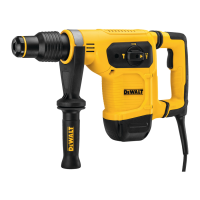7
ENGLISH
Bit and Bit Holder
WARNING: Burn Hazard. ALWAYS wear gloves when
changing bits. Accessible metal parts on the tool and bits
may get extremely hot during operation. Small bits of
broken material may damage barehands.
WARNING: Do not attempt to tighten or loosen drill bits
(or any other accessory) by gripping the front part of the
chuck and turning the tool on. Damage to the chuck and
personal injury mayoccur.
The rotary hammer can be fitted with various chisel bits
depending on the desired application. Use sharp drill
bitsonly.
Inserting and Removing SDS Bits (Fig. C)
1. Pull back the locking sleeve
8
and insert the bit shank. The
bit shank must beclean.
2. Turn the bit slightly until the sleeve snaps back intoposition.
3. Ensure the bit is properlyengaged.
NOTE: The bit needs to move several centimeters in and out
of the bit holder
7
when properlyengaged.
To remove the bit, pull back the locking sleeve and pull the
bitout.
OPERATION
Instructions for Use
WARNING: Always observe the safety instructions and
applicableregulations.
WARNING: To reduce the risk of serious personal
injury, turn tool off and disconnect tool from power
source before making any adjustments or removing/
installing attachments or accessories. Be sure the
trigger switch is in the OFF position. An accidental start-up
can causeinjury.
Proper Hand Position (Fig. D)
WARNING: To reduce the risk of serious personal injury,
ALWAYS use proper hand position asshown.
WARNING: To reduce the risk of serious personal
injury, ALWAYS hold securely in anticipation of
asuddenreaction.
Proper hand position requires one hand on the mounted side
handle, with the other hand on the mainhandle.
Overload Clutch
In case of jamming of adrill bit, the drive to the drill spindle is
interrupted by the overload clutch. Due to the resulting forces,
always hold the tool with both hands and take afirmstance.
After the overload, release and depress the trigger to
re-engagedrive.
Mechanical Clutch
These tools are fitted with amechanical clutch. The indication
that the clutch has activated will be an audible ratcheting
together with increasedvibration.
WARNING: Drill may stall if overloaded causing asudden
twist. Always expect the stall. Grip the drill firmly to control
the twisting action and avoidinjury.
Operation Modes (Fig. E)
WARNING: Do not select the operating mode when the
tool isrunning.
CAUTION: Never use in Rotary Drilling or Rotary
Hammering mode with achisel bit in the bit holder.
Personal injury and damage to the the tool mayresult.
Your tool is equipped with amode selector dial
4
to selectthe
mode appropriate to desiredoperation.
Symbol Mode Application
Rotary Drilling Dry diamond coring
Rotary
Hammering
Drilling into concrete and masonry
Hammering only Light chipping
To select an operating mode:
1. Depress the mode selector release button
5
.
2. Rotate the mode selector dial so that the arrow points to the
symbol corresponding for the desiredmode.
NOTE: The arrow on the mode selector dial
4
must be pointing
at amode symbol at all times. There are no operable positions
inbetween. It may be necessary to briefly run the motor after
having changed from 'hammering only' to 'rotary' modes in
order to align thegears.
Performing an Application (Fig. A, E)
WARNING: Always wait until the motor has come to
acomplete standstill before changing the direction
ofrotation.
1. Choose and install the appropriate chuck, adapter, and/or
bit onto to the tool. Refer to Bit and BitHolder.
2. Using the mode selector dial
4
, selectthe mode
appropriate to desired application. Refer to
OperationModes.
3. Adjust the side handle
2
asnecessary.
4. Place the bit/chisel on the desiredlocation.
5. Depress the trigger switch
1
.
6. To stop the hammer, release theswitch.
Recommendations for Tool Operation
• When drilling, always apply pressure in astraight line with
the bit, but do not push hard enough to stall the motor or
deflect thebit. Asmooth even flow of material indicates the
proper drillingrate.
• Your hammer can be used for dry diamond drilling into
masonry up to 100 mm. For diamond drilling above this
diameter in masonry and regular large diameter diamond
drilling in masonry and concrete, we advise the use of
adedicated diamond core drill. Follow the core bit or
manufacturer’srecommendations for using the accessory.

